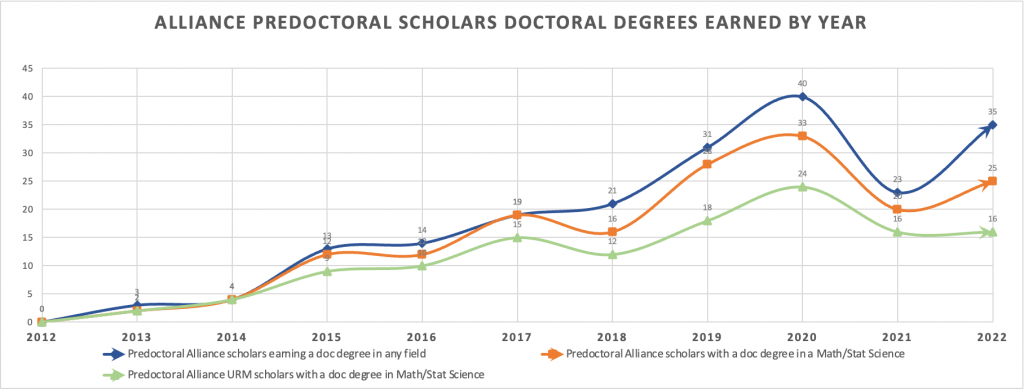The Math Alliance
David Goldberg, Jacqueline Hughes-Oliver, Leslie McClure, and Javier Rojo
The Justice, Equity, Diversity, and Inclusion (JEDI) Outreach Group Corner is a regular component of Amstat News in which statisticians write about and educate our community about JEDI-related matters. If you have an idea or article for the column, email the JEDI Corner manager.
By the Numbers
As the Math Alliance has grown, so has its success. When the Math Alliance became a national entity in 2007, there were 17 mentors and 59 students. Currently, the community has grown to 1,376 mentors at more than 410 colleges and universities. Of these mentors, 292 describe their research as involving statistical or data science, including 213 in doctoral programs.There have been more than 2,500 Math Alliance scholars since 2007. Of scholars disclosing race or ethnicity, 80 percent self identify as an underrepresented minority (as defined by the National Science Foundation).
To date, at least 208 Math Alliance predoctoral scholars have earned doctorates. This includes at least 31 doctorates in statistical sciences. More than 900 students have participated in the facilitated graduate admissions procedure; 232 of those scholars are currently in doctoral programs. At least 56 scholars who participated in the facilitated graduate admissions procedure have earned doctorates, including at least eight in the statistical sciences.
The Math Alliance is a national mentoring community of faculty (mentors) and students (scholars) focusing on increasing traditionally excluded American minorities in the quantitative sciences professions. It began in the mid-1990s as an effort by the University of Iowa Department of Mathematics faculty to increase the number of underrepresented PhD students in the department. The project grew into a consortium among the three Iowa Regents Universities and four historically Black colleges and universities and was supported by an Infrastructure Grant by the National Science Foundation Division of Mathematical Sciences. In 2007, it transitioned to a national program and, in 2016, moved its administrative home to Purdue University.
Since its beginning, statistical sciences has had a strong presence in the Math Alliance. The late Kathryn Chaloner was a co-director and member of the board of directors. She began the Math Alliance Statistics Initiative to ensure statistical and data sciences were always well represented and to introduce scholars to statistics.
Several mechanisms within the Math Alliance facilitate students’ transition into doctoral programs and the professions. Mentors are responsible for identifying and nominating Math Alliance scholars, thus every student comes to the alliance with a mentor. Graduate programs can be certified as graduate program groups, indicating a welcoming and supportive environment for Math Alliance scholars. There are now 42 doctoral program groups and 11 master’s program groups, which also demonstrate clear paths to doctoral studies. At least 16 doctoral and four master’s program groups grant statistical science degrees. There is also a regional structure, with autonomous organizations providing community and activities to a wide range of students and institutions in specific geographical areas.
Academic institutions, professional organizations, and corporations can become partners in the administrative Center for the National Math Sciences Alliance. Bristol Meyers Squibb recently became a partner, though the company has been engaging the community with a monthly “hot topics” session for the last couple of years. These sessions feature professionals with a wide range of expertise presenting insights into career options.
The Math Alliance structure relies on mentors to engage students and nominate scholars. Mentors sign up on the Math Alliance website. Currently, the alliance needs mentors from outside academia and is developing a mentoring corps from government, industry, professional organizations, and business.

Attendees pick up their materials at the Field of Dreams Conference Graduate Fair registration table.
Photo by Donald Cole
Scholars who are within two years of completing a BS, bridge, or terminal MS program can become part of the facilitated graduate admissions procedure, where they are matched with a mentor in a doctoral program (faculty facilitator). The scholar, facilitator, and scholar’s nominating mentor then work as a team to navigate the graduate application process. These scholars can also participate in the Career Paths Workshop, a two-day meeting to help illuminate the myriad careers and disciplines for which strong quantitative training is considered excellent preparation.
The entire Math Alliance community comes together for the annual Field of Dreams Conference, which includes about 200 undergraduate and terminal MS students, along with current doctoral students; Math Alliance mentors; and representatives from graduate programs, professional societies, and corporations. The conference features a series of panels that provide critical information about selecting and thriving in a graduate program. There are community-building activities for mentors and scholars, three plenary sessions (including the Kathryn Chaloner Memorial Lecture in the Statistical Sciences and their Applications), a fair for students to connect with internships and research experiences for undergraduates, a graduate program fair, and a career fair for Math Alliance scholars who have earned doctorates.
All authors of this month’s JEDI Corner are leaders and mentors in the Math Alliance. David Goldberg is the executive director; Jacqueline Hughes-Oliver is associate director of statistics and a member of the executive council; Leslie McClure is on the executive council and served as its chair for three years; and Javier Rojo is associate director for biostatistics and data science.



















Leave your response!